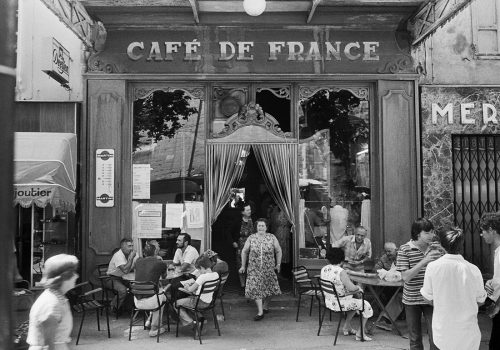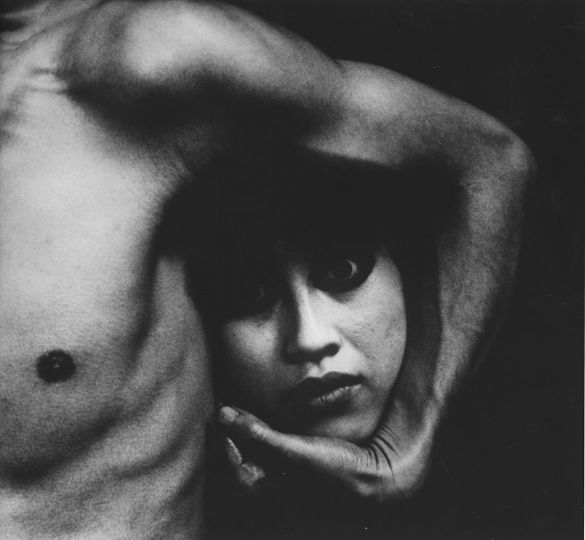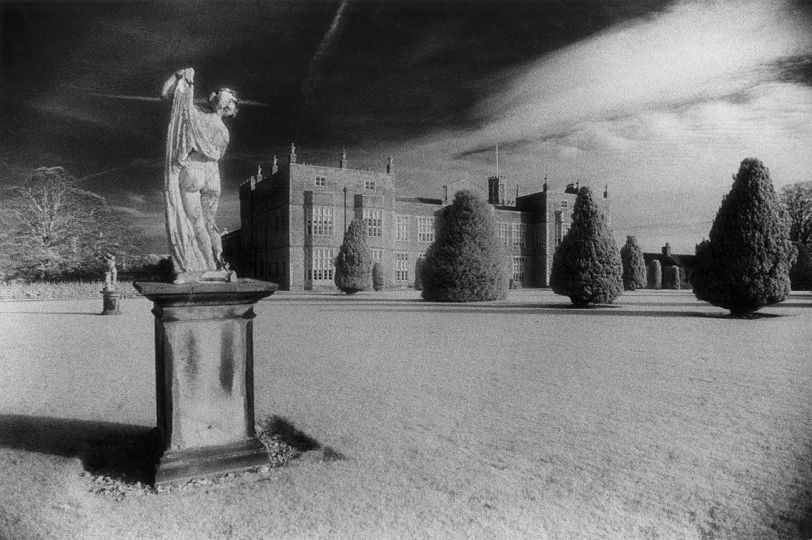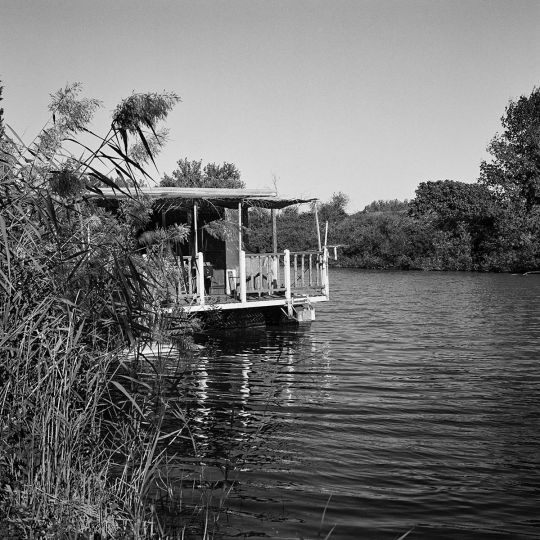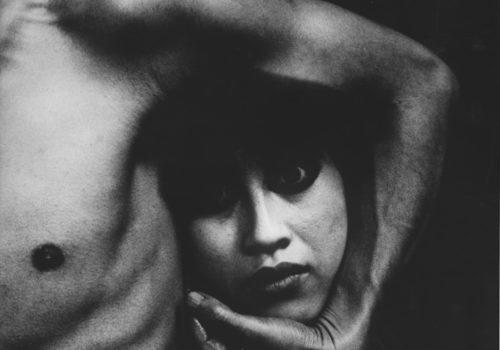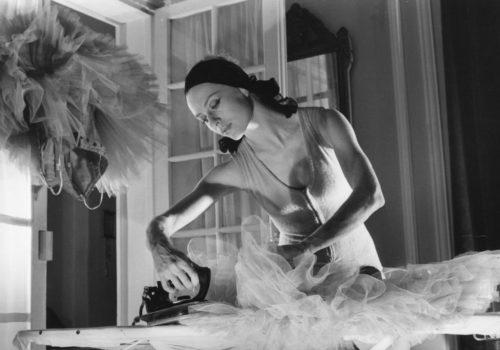The love at first sight of Willy Ronis for Gordes, this emblematic village of Provence is a happy coincidence. Raymond Grosset, director of the Rapho agency that Ronis integrated after the war, asked him one day to enjoy his holidays in the south to make a report on the painter André Lhote and his summer school in Mirmande, in the Drôme. The session goes so well that in the end André Lhote offers him to continue this work in his other summer school located in Gordes. This is what Willy Ronis will do and it is in this last workshop that he will realize the portrait of the painter, holding in his hand an empty frame in the valley of Apt. “It could be later, the cover photo for yet another reissue of your famous” Landscape Treaty, “he adds. A walk in this village, accompanied by his wife Marie-Anne, completes their conquest by the beauty of the site and the simplicity of urban life. “The village fascinates us and we will find a ruin, the following year, for the future holidays”.
Indeed, on the occasion of another report on the goure of Caladoire near Avignon in March 1948, Ronis returns to Gordes. They buy an old house in ruins: “La Vieille Vieille” rue de la Calade. From July begin emergency work. They are numerous: no electricity, no water. But the device is always ready. The chore of water is an excellent subject as are the few craftsmen at work: carpenters, masons. It is also in this house that will be realized the famous photograph “The Provençal nude”, where Marie-Anne refreshes herself with the water of a bowl. An image that has become iconic in its simplicity and tenderness and will be chosen by Edward Steichen to appear in the famous exhibition “The Family of Man” inaugurated in 1955 in New York. “This is a fetish photo published since then without interruption here and everywhere. The miracle exists, I met him. ”
So many images that feed the archives and respond to possible orders. The friends of passage, Raymond Grosset, Martinez, the Doisneau family visit him and discover the region where, from 1949 to 1952, many pavilions are built. The opportunity for Ronis to multiply photographs of bright landscapes and craftsmen at work that will often be published by magazines like “Houses and Gardens”. Willy Ronis will come back regularly to each summer vacation, and sometimes on the occasion of reports, on this Provence, where he excels to play with the lights between the narrow lanes, the shady squares, while capturing the daily life and an art to live endangered.
In 1958, Willy Ronis acquires a small wheelhouse near his house which, after being intended to accommodate visiting friends, will become his main home. It is there that Izis, seduced by a report of Ronis on Gordes published by “Photorama” one of the magazines of decoration which counts his customers, will come and fascinated by the site, will decide on the field to buy a neighboring house where both will meet regularly. Just as they meet the many known or unknown personalities who settle in the region: Fougeron, Lotar, Grosset, Martinez, Andre Lhote or Vasarely.
In the 1950s, Ronis discovered the systematic discovery of the region that he traveled by bike or motorbike, occasionally making numerous reports on the landscapes and characters he photographs with great empathy in their activity: the old-fashioned plowing at Bonnieux, the mowing of wheat with the roller, the Santoners of the Crémade, the carder or the postman at L’Isle-sur-la-Sorgue. As he captures with simplicity the daily life of these villages such as the interior of the café in Venasque, the facade of Francis at Saint-Saturnin-les-Apt. A large number of these images will also be the subject of a large exhibition “The Provence of the mountains” in 1969. Without forgetting these small intimate and tender family scenes where the family life unfolds smoothly: rest in the attic , only habitable room at the beginning, the games of Vincent in the garden or the meal in the kitchen stay in The Old House which will be, moreover, sold in 1969.
But the economic situation of the majority of photographers worsens in the 60s when, with the arrival of television, the press mutates deeply. Some titles disappear, others profoundly change their visual policy, preferring raw documentary to in-depth reporting.
Ronis’ moral integrity also led him, in 1951, to interrupt his collaboration with the magazine “Life”, which he criticized for not respecting his own legends. As many serious decisions that will make him quickly know professional and financial di culties that led him, in 1972, to leave Paris to settle in Gordes. Teaching will then become one of Willy Ronis’ main activities. From the end of 1971, he taught at the School of Fine Arts and Architecture of Avignon. Then at the faculty of letters of Aix-en-Provence. The teaching of photography is almost nonexistent in France at this time, Ronis realizes there a real work of pioneer who gains some success with the students. But in this small village too isolated, Marie-Anne is bored, the couple will move in 1976 to settle in L’Isle-sur-la-Sorgue, more lively city where Willy Ronis will multiply the shots and furrow the surroundings. The old wheels of the Comtadine city, the boules players of the Villevieille district, the market scenes, the Santon collection of the Hotel de Palerna are all executives in which Willy Ronis organizes his little theater in the street.
If he is not, properly speaking, a landscape painter, he roams with pleasure the roads of Cavaillon Carpentras, delighting with the particular topology of this region, the Penitents of the Mées, the arid slopes of Ventoux or enigmatic Bories .
The courses ceasing in 1975 in Aix-en-Provence then in 1977 in Avignon, he takes the principle to the faculty of Marseille in October 1978. At the same time he works a lot in his laboratory to classify and shoot some clichés. In addition, the Rencontres d’Arles were born in 1970. Willy Ronis will go there and find a few rare friends, but remains initially completely anonymous in the eyes of the crowd.
It was not until 1979 that his name resurfaced on the occasion of an order placed by the Ministry of Culture to ten photographers, a report on the subject of their choice. “I choose to represent the many aspects of the small town where I live at the time, Isle-sur-la-Sorgue in Vaucluse, as well as characteristic sites of the township.” The work will be presented as part of the Heritage Year at the Pompidou Center in Paris. Coincidence or not, the Grand Prix National des Arts et Lettres is awarded the same year.
The following year he is the guest of honor at the 11th Rencontres de la photographie in Arles where his evening is received triumphantly. This is the beginning of a series of exhibitions and national and international publications that will not cease and that will bring its fame to the highest. An activity that will lead to a new life change.
In 1983, he relocated to Paris after having donated six large albums composed of photographs selected by himself among which many of the images in this exhibition. Photographs that express perfectly the pleasure that was hers to stay “between Luberon and Ventoux in a small comtadine town, where I am well, Marie-Anne by my side, the sun in shambles, this campaign blessed with orchards and vines separated from rows of black cypress hedges, which I cycle with the friend Brunet (…) “.
He will never forget this Provence quite since a few months of his 100 years, despite his state of tiredness, he will once again be one of the guests of the 40th Rencontres de la Photographie of Arles in 2009 where the welcome will be triumphant. Willy Ronis will die three months later.
Jean-Claude Gautrand
The Luberon of Willy Ronis
From June 29 to November 2, 2019
Chapelle du Grand Couvent
Cavaillon

